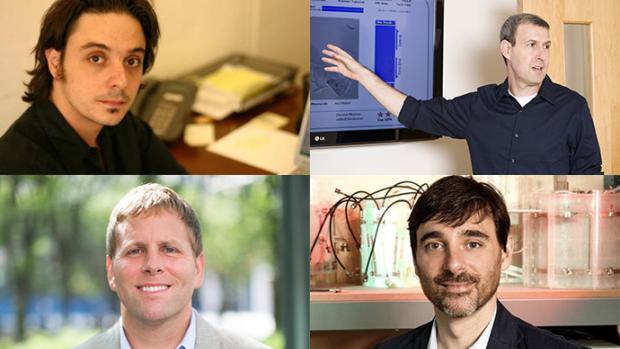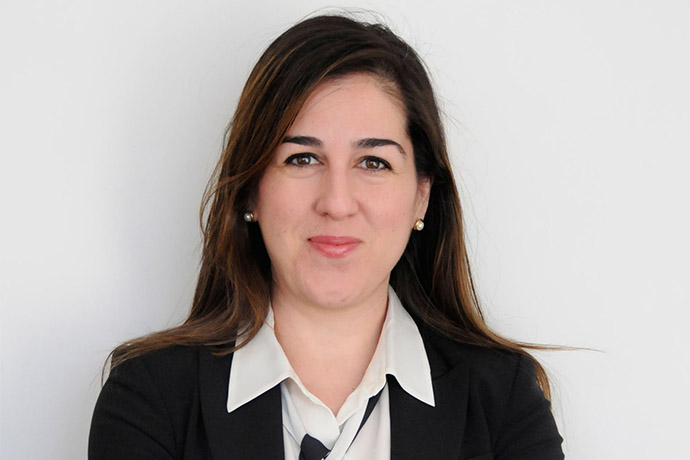Professors Recognized for Promise
National Science Foundation Recognizes Young Faculty with CAREER Award

Ask students here what makes their school special, and you’ll hear time and time again that it’s the professors. The NYU Tandon School of Engineering offers a place where even undergraduates can work side by side with world-class professors whose mission is not only to conduct their own cutting-edge research, but to educate the next generation of technologists, scientists, and innovators.
For affirmation that those students are correct, look no further than the National Science Foundation (NSF), which has recognized numerous young faculty members here with its Faculty Early Career Development (CAREER) Award, meant to support “the early career development activities of those teacher-scholars who are most likely to become the academic leaders of the 21st century.”
Below are just a few of the teacher-scholars making their names at the School of Engineering and inspiring their students to heights of their own.
Professor of Mechanical Engineering Maurizio Porfiri was the recipient of the CAREER Award in 2008, when he announced his intention to “close the loop between engineering and nature” through a study of engineered guidance and control of fish shoals, where bio-mimetic robotic fish would be placed within live fish environments. The goal of the research was to improve the current understanding of complex multi-agent dynamical systems, and Porfiri now says that the NSF award “launched [his] career on animal-robot interactions, harmoniously integrating [his] technical background in dynamical systems with [his] personal curiosity in behavioral science.”
Since then, he has received numerous other honors, including designation by the editors of Popular Science as one of the most brilliant young researchers of 2010; the American Society of Mechanical Engineers (ASME) 2013 Gary Anderson Early Achievement Award for his contributions to the field of smart structures and materials; and the ASME Dynamic Systems and Controls Division’s 2013 Outstanding Young Investigator Award for his contributions to biomimetic underwater robotics and the collective dynamics of networked dynamical systems.
Associate Professor of Technology Management and Innovation Oded Nov, whose work focuses on social computing and explores the social dynamics that shape technology-enabled collaborations, received his CAREER Award in 2012 and has since then embarked on numerous projects—including one examining the patterns through which individuals collaboratively create large scale repositories of knowledge, such as Wikipedia.
“What’s interesting here,” he has said, “is that despite the fact that this is part of a growing trend of huge efforts built on volunteers, we know very little about its dynamics. It’s important to study and improve the design of socio-technical systems. By better understanding and through the use of large-scale experiments, we can enhance the recruitment and retention of volunteers, as well as make online community-based efforts more effective.”
Nov’s many other laurels include a Google Focused Research Award and multiple invitations to participate in the annual National Academies Keck Futures Initiative (NAKFI), which brings together some of the nation’s best researchers from academic, industrial, and government laboratories to explore and discover interdisciplinary connections in important areas of cutting-edge research.
Assistant Professor of Chemical and Biomolecular Engineering Ryan Hartman is a 2015 CAREER Award laureate and is using his grant to research methane—the most stable of the carbon compounds and therefore the one that poses the most difficulty in separating its bonds at moderate temperatures. The resulting scientific discoveries and processes could reduce by at least one order of magnitude the cost of synthesizing certain less-stable molecules used in the manufacture of pharmaceuticals as well as fine chemicals, which are pure enough to use in manufacturing and research.
Although technical innovations over the last decade have greatly increased the supply of domestic natural gas, Hartman explains that significant challenges remain in devising novel, economical approaches to upgrading its components at moderate temperatures. His work in gas hydrates could also help solve a vexing problem related to plugging in hydrocarbon and natural-gas pipelines.
Assistant Professor of Electrical and Computer Engineering Riccardo Lattanzi received his CAREER Award in 2015 and is now engaged in efforts to advance the fundamental understanding of how radiofrequency (RF) electromagnetic (EM) fields interact with biological tissue, and use that knowledge to improve the diagnostic power of magnetic resonance imaging (MRI), among other goals.
“We have been working on the construction of a multi-compartment phantom that mimics the electrical properties of biological tissues,” he explains. “We will use it for the validation of the electrical properties mapping techniques that are being developed for the grant project. This work requires building a waterproof plastic phantom with multiple compartments separated by boundaries as thin as possible to avoid artifacts when reconstructing maps of the electrical properties, and creating water or gelatinous solutions that have the same electrical conductivity and permittivity of biological tissues.”
Lattanzi’s work has industrial applications beyond the hospital radiology suite. Satisfying the safety regulatory requirements for wireless devices like cell phones, for example, currently depends on probe-based methods of EM field mapping, but Lattanzi, who is now collaborating with a team from MIT, predicts that the technique he and his colleagues are developing will make possible marked improvements in speed and accuracy over those relatively crude methods.
Siddharth Garg, a member of the computer hardware security research team received a CAREER Award in 2016. Read the Press Release.
The NSF is far from being the only organization honoring the efforts of early-career superstars.
The objective of the Defense Advanced Research Projects Agency (DARPA) Young Faculty Award program is to identify and engage rising research stars at U.S. academic institutions and introduce them to Department of Defense needs, so that they might develop their research ideas in the context of national security needs.
Among the most-recent recipients of the generous grant is Assistant Professor of Civil and Urban Engineering Semiha Ergan, who will be working to understand the interrelations between neuroscience and built environment, and the degree to which the built environment contributes to increased human performance and context awareness. Such an understanding is critical, she explains, since 90% of time in a typical day is spent indoors, and architectural features impact the productivity, health and comfort of occupants.

Among the other prizes available are — to name just a few:
- The Freudenstein / General Motors Young Investigator Award, won by Assistant Professor of Mechanical Engineering Joo H. Kim for advancing the study of energy expenditure in robotic systems;
- The Baxter Young Investigator Award for medical innovation, won by Assistant Professor in the Department of Mechanical and Aerospace Engineering Weiqiang Chen;
- The Air Force Young Investigator Research Program Award, won by Associate Professor of Chemical and Biomolecular Engineering Jin Kim Montclare;
- And the American Society for Bone and Mineral Research (ASBMR) Young Investigator Award, won by Assistant Professor of Mechanical Engineering Alesha B. Castillo.

